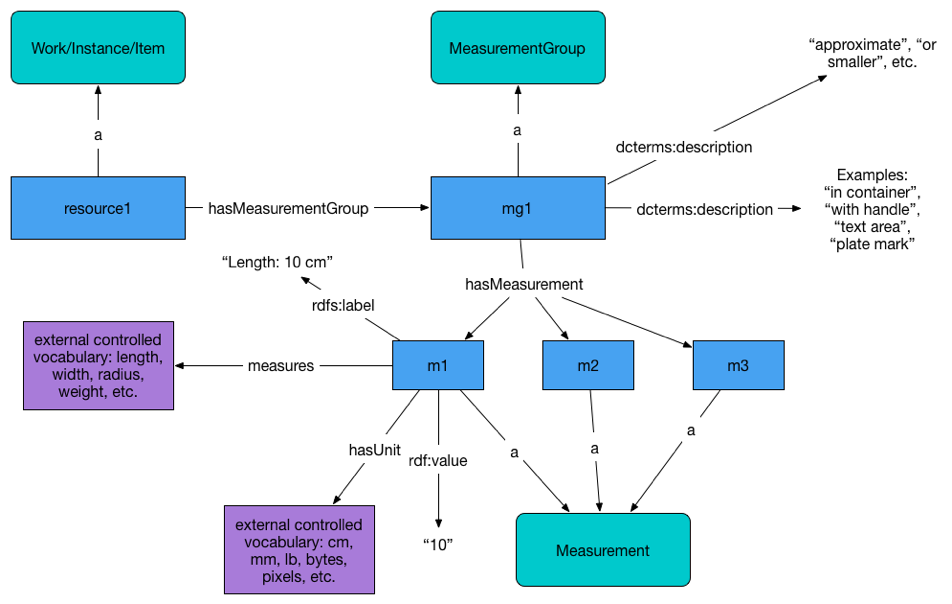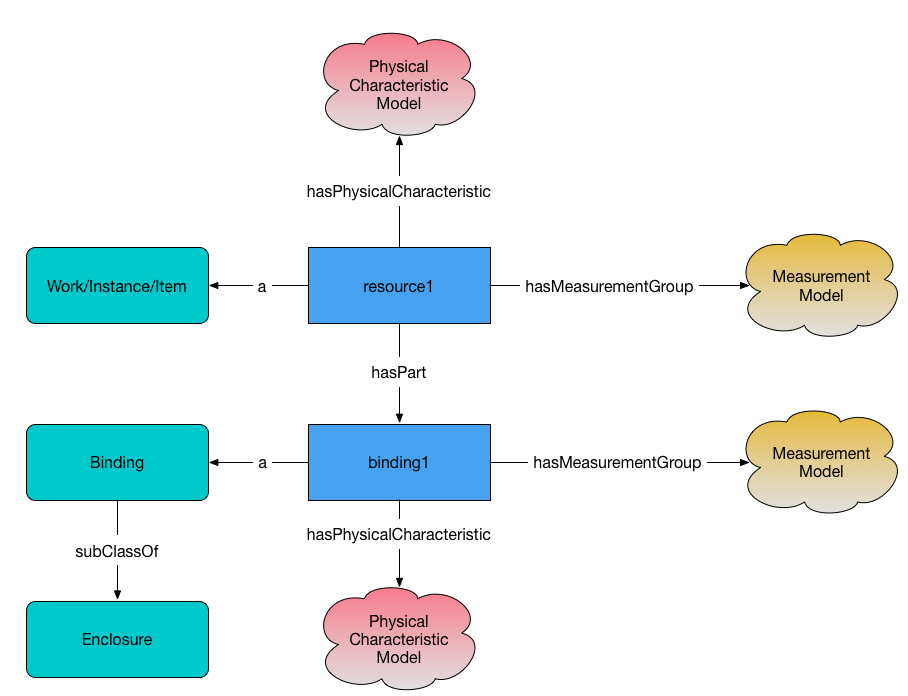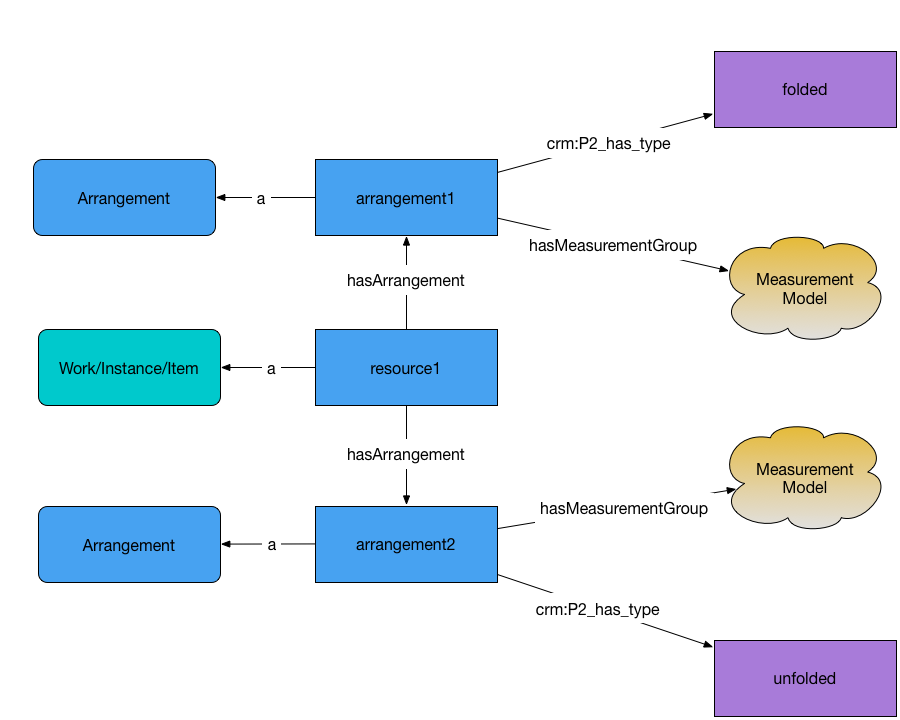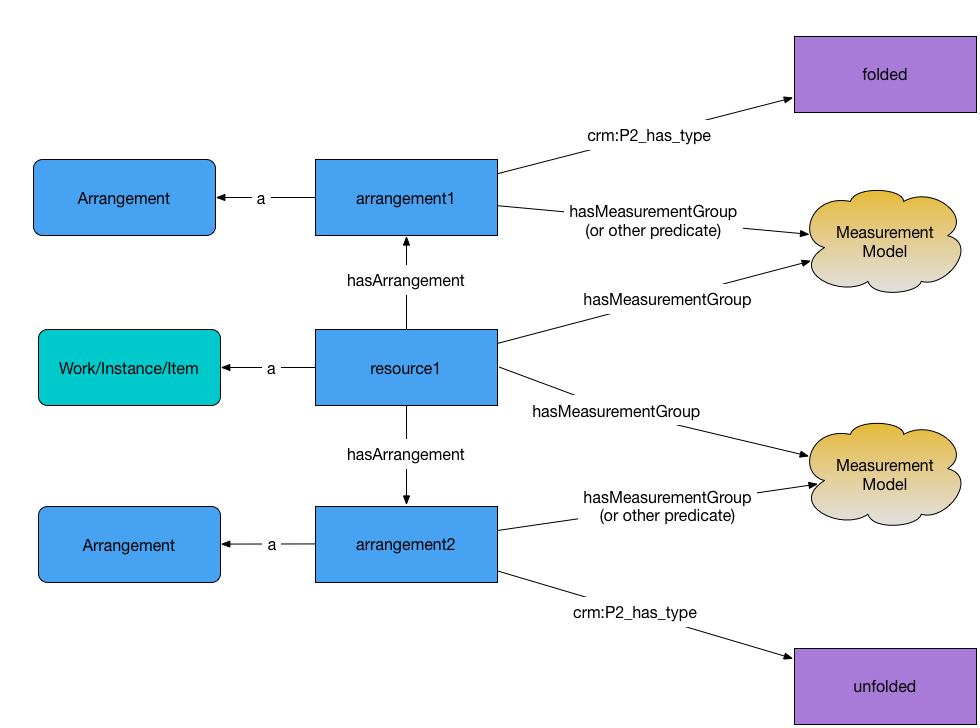arm
Measurements of Whole, Part, and Arrangement
ArtFrame and RareMat, 2017-08-10
Table of Contents
Overview
In current MARC cataloging practice dimensions are recorded in one single subfield (300 $c) even if the content standard or domain specific cataloging practice direct the cataloger to record the measurements in much more detail. BIBFRAME has carried this forward by defining the datatype property bf:dimensions. However, there are number of domain specific ontologies (such as QUDT, VRA RDF and CIDOC CRM) that do provide more granularity and in 2015 a discussion paper was submitted to the Committee on Cataloging: Description & Access to expand RDA instructions in this area. Measurements were also identified at the In-Person Meeting of ArtFrame and the Rare Materials Ontology Extension groups as an area in need of more in-depth modeling.
The above mentioned ontologies and the RDA discussion paper were all considered for possible reuse and informed the proposed bibliotek-o pattern. QUDT does not support the ability to specify which part of an object was measured (e.g. visible image or written space) or in which arrangement the object was when it was measured (e.g. rolled or folded). However, the QUDT Units Ontology can be re-used to express measurement units such as inches or centimeter.
CIDOC-CRM appears to be a somewhat closed ecosystem that diverse schema and ontologies can map to in a universal way. We therefore recommend that bibliotek-o defines its own measurement pattern that should be aligned with the CIDOC-CRM.
Recommendations were tested on sample data pulled from existing descriptions.
While the measurement model was developed specifically to address the descriptive needs of bibliographic items in the art and rare materials domains, we define it as an independent model with the expectation that it could be useful in the description of a broad range of resources.
Relevant Documentation
Summary of Recommendations
- Use of rdfs:label provides a human-readable form of the measurement
- Use rdf:value for numeric values
- Use dcterms:description when describing or specifying the part or arrangement being measured when this cannot be identified as a distinct resource and for qualifiers like “approximately”, “or smaller”, etc.
- Use dcterms:hasPart to express measurements that only apply to a specific part of a resource that can be identified as a distinct resource.
-
Use bf:Unit: Request clarification from LC regarding the intent of this class before considering its use. The definition bf:Unit appears to be inline for this measurement model, but the use of it as the range of bf:unit seems to imply a different intent.
- Define the following new classes:
- ex:MeasurementGroup
- ex:Measurement
- ex:Arrangement [request that LC broadens the definition of bf:Arrangement to include our use case, the organization and collection of a single item.]
- Define the following new properties:
- ex:hasMeasurementGroup
- ex:isMeasurementGroupOf
- ex:hasMeasurement
- ex:isMeasurementOf
- ex:measures
- ex:measuredBy
- ex:hasUnit
- ex:isUnitOf
- ex:hasArrangement [request that LC broadens the definition of bf:arrangement to include our use case, the organization and collection of a single item.]
- Value vocabularies:
- For units, use NASA QUDT Units Ontology http://www.qudt.org/qudt/owl/1.0.0/unit/index.html
- For arrangements, such as rolled, folded, etc. a vocabulary will have to be developed. Since these arrangements cover several domains (for example several types of resources can potentially be folded) it might be best served in bibliotek-o or a distinct measurements “utility” ontology.
- For dimension types, such as height, width, weight, etc. use AAT, Art & Architecture Thesaurus.
- For parts measured (e.g. container, mount, platemark): Each domain implementing this model will need to define their own classes.
BIBFRAME Approach to Measurements
bf:dimensions
- Label: Dimensions
- IRI: http://id.loc.gov/ontologies/bibframe/dimensions
- Range: Literal
- Definition: Measurements of the carrier or carriers and/or the container of a resource.
Recommended Approach to Measurements
Involved Classes
ex:MeasurementGroup
- Label: Measurement Group
- IRI: tbd
- Definition: A set of measurements pertaining to a specific resource, part of a resource, or resource in a particular arrangement. For example, a book may have a specified height, width, length, and/or weight, which are all attached to a MeasurementGroup; the binding may have measurements specified independently, which would constitute another MeasurementGroup. A MeasurementGroup has one or more specific Measurements attached to it.
ex:Measurement
- Label: Measurement
- IRI: tbd
- Definition: The measurement of a single aspect of a resource, including value, units, and the aspect measured. For example, a book may have a height (aspect) of 10 (value) centimeters (units). Each such measurement is attached to a MeasurementGroup.
ex:Arrangement
- Label: Arrangement
- IRI: tbd
- Definition: The arrangement, organization, or configuration of a single object or collection of objects. For example, a parchment may be rolled or unrolled; a collection of visual materials has a specific arrangement; computer files are organized and ordered in a specific way.
Involved Properties
ex:hasMeasurementGroup (Object property)
- Label: has measurement group
- IRI: tbd
- Definition: The relationship of a resource to a measurement group, indicating that the measurement group applies to the resource.
- Domain: Unspecified
- Range: ex:MeasurementGroup
- Inverse: ex:isMeasurementGroupOf
ex:isMeasurementGroupOf (Object property)
- Label: is measurement group of
- IRI: tbd
- Definition: The relationship of a measurement group to a resource, indicating that the measurement group applies to the resource.
- Domain: ex:MeasurementGroup
- Range: Unspecified
- Inverse: ex:hasMeasurementGroup
ex:hasMeasurement (Object property)
- Label: has measurement
- IRI: tbd
- Definition: The relationship of a MeasurementGroup to a Measurement, indicating that the Measurement is one part of the MeasurementGroup.
- Domain: Unspecified
- Range: ex:Measurement
- Inverse: ex:isMeasurementOf
ex:isMeasurementOf (Object property)
- Label: is measurement of
- IRI: tbd
- Definition: The relationship of a Measurement to a MeasurementGroup, indicating that the Measurement is one part of the MeasurementGroup.
- Domain: ex:Measurement
- Range: ex:MeasurementGroup
- Inverse: ex:hasMeasurement
ex:measures (Object property)
- Label: measures
- IRI: tbd
- Definition: The relationship between a Measurement and the dimension or other aspect of a resource that is measured by this Measurement. For example, a Measurement may specify the length, height, weight, file size, etc. of a resource.
- Domain: ex:Measurement
- Range: Unspecified
- Inverse: ex:measuredBy
ex:measuredBy (Object property)
- Label: measured by
- IRI: tbd
- Definition: The relationship between a dimension or other aspect of a resource and the Measurement that measures it. For example, the length, height, weight, file size, etc. of a resource may be the aspect that is measured by a particular Measurement.
- Domain: Unspecified
- Range: ex:Measurement
- Inverse: ex:measures
ex:hasUnit (Object property)
- Label: has unit
- IRI: tbd
- Definition: Relationship between the measurement and the unit used to express the measurement.
- Domain: Unspecified
- Range: Unspecified
- Inverse: ex:isUnitOf
ex:isUnitOf (Object property)
- Label: is unit of
- IRI: tbd
- Definition: Relationship between the measurement and the unit used to express the measurement.
- Domain: Unspecified
- Range: Unspecified
- Inverse: ex:hasUnit
ex:hasArrangement (Object property)
- Label: has arrangement
- IRI: tbd
- Definition: Relationship between the resource and a specified arrangement, organization, or configuration of it.
- Domain: Unspecified
- Range: ex:Arrangement
- Inverse: ex:isArrangementOf
ex:isArrangementOf
- Label: is arrangement of
- IRI: tbd
- Definition: Relationship between a specified arrangement, organization, or configuration and a resource.
- Domain: ex:Arrangement
- Range: Unspecified
- Inverse: ex:hasArrangement
dcterms:hasPart
- Label: Has Part
- IRI: http://purl.org/dc/terms/hasPart
- Definition: A related resource that is included either physically or logically in the described resource.
- Note: This term is intended to be used with non-literal values as defined in the DCMI Abstract Model (http://dublincore.org/documents/abstract-model/). As of December 2007, the DCMI Usage Board is seeking a way to express this intention with a formal range declaration.
- subPropertyOf: http://purl.org/dc/terms/relation
dcterms:description
- Label: Description
- IRI:http://purl.org/dc/elements/1.1/description
- Definition: An account of the resource.
- Comment: Description may include but is not limited to: an abstract, a table of contents, a graphical representation, or a free-text account of the resource.
- Note: A second property with the same name as this property has been declared in the dcterms: namespace (http://purl.org/dc/terms/). See the Introduction to the document “DCMI Metadata Terms” (http://dublincore.org/documents/dcmi-terms/) for an explanation.
Diagrams and Discussion
The diagrams illustrate models of measurements of a resource, a part of the resource, and the resource in a particular arrangement.
Diagram 1: Basic measurement model with optional descriptions

Notes
-
rdfs:label provides a human-readable form of the measurement.
-
The measurement classes and predicates are not subclasses / subproperties of PhysicalCharacteristic and hasPhysicalCharacteristic, in order to allow use for digital and other non-physical measurements (file size, pixels, bytes, etc.). Whether or not the model is used in this way in our descriptions is an implementation issue.
-
dcterms:description is used to describe or specify the part or arrangement being measured when this cannot be identified as a distinct resource, as in Diagram 3. For example, a resource may be measured in a container which is then thrown away, so it makes no sense to model it as a resource. See other examples in the diagram.
-
Qualifiers will provisionally be expressed using dcterms:description. We will leave the question of using a different predicate with a controlled vocabulary (approximate, or smaller, etc.) as future work.
-
Note that each value of dcterms:description is atomic: there should be one assertion for each literal value, rather than combining values into a composite string.
Diagram 2: Single resource with multiple measurement group and descriptions

Notes
- The use of dcterms:descriptions is similar to the use of Arrangement resources (see Diagram 5) to describe different measurements for a resource in different states, but description literals are used in cases where a controlled vocabulary cannot be defined due to wide or perhaps unlimited variability.
Diagram 3: Measurements of whole and part: part a resource

Notes
- For domain extensions: Identify classes for parts of resources like binding, frame, etc. Should there be a superclass?
Diagram 4: Measurements of whole and part with additional physical characteristics

Notes
- Demonstrates that when a part of a resource, such as a binding or frame, is recognized as a distinct resource, other assertions can be made about it (color, material, etc.).
Diagram 5: Measurements of arrangement: arrangement is a resource

Notes/TBD
-
Rationale for an arrangement object is not necessarily that there are other assertions to be made about it, but that a controlled vocabulary of states, rather than literal values, can be used.
-
Examples of resources with arrangements: road maps (folded/unfolded), parchments (rolled/unrolled), book (open/closed).
-
The use of arrangements is similar to the use of dcterms:descriptions to associate different measurements with a resource (see Diagram 2, but in the case of arrangements it is possible to define a controlled vocabulary.
-
The measurements attached directly to the Work/Instance/Item resource do not specify a particular arrangement, but presumably it is different from the folded arrangement.
-
Find or define controlled vocabulary for physical arrangement.
Diagram 6: Measurements of arrangements: multiple arrangement resources

Notes/TBD
- In this version, two arrangements are expressed as separate resources, without a default or unspecified arrangement. Choice of model 5 vs 6 would be an implementation decision by the cataloger, but use of 6 is recommended for consistency when each arrangement can be identified.
Areas for Future Research
- Measurements of specific arrangements of a resource. As illustrated in Diagrams 5 and 6, when a MeasurementGroup applies to a specific arrangement of a resource, the model proposes that it is attached directly to the Arrangement and only indirectly to the resource itself. This creates an asymmetry between this and other scenarios, where the predicates hasMeasurementGroup/isMeasurementGroupOf link the MeasurementGroup directly to the Item, Instance, or other resource; this in turn results in non-uniform querying of these scenarios. One might propose an alternative model in which the MeasurementGroup is directly attached to the resource, as in other cases, and linked to the Arrangement, either using hasMeasurementGroup again, or via some other suitable predicate with the semantics “measures arrangement of.” However, the Arrangement nevertheless does need to attach directly to the resource, since it is a descriptor of the resource itself independent of any measurements. One could contemplate a triangular model in which each resource attaches directly (but redundantly) to both of the others, as in Diagram 7. The larger research question is whether introducing redundancy into a model for the sake of maintaining uniform modeling and query patterns is preferable to maintaing non-uniform models to avoid redundancy, noting that redundancy creates data maintenance problems.
Diagram 7: Triangulated Resource, Arrangement, and Measurement
